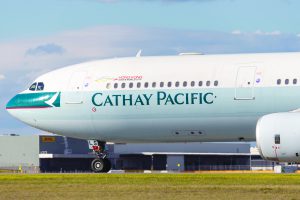BLOOMBERG
After being hit during the pandemic harder than pretty much any airline still flying, Cathay Pacific Airways Ltd has a very good chance of posting a net profit this year and returning to full capacity in 2024, according to Chief Executive Officer Ronald Lam.
Covid-related disruption had such an impact on Hong Kong air travel that on one day in March last year, Cathay flew just 58 passengers. The situation has improved since mandatory quarantine was dropped in September, with Cathay’s average daily passenger numbers topping 33,000 in January. But there’s more to do before Lam can restore its standing as one of the world’s premier airlines.
“It’s going to be a little bit of a tunnel to still go through,†Lam told Bloomberg Television in one of his first interviews with international media since becoming CEO of the 76-year-old airline on January 1.
Cathay — which was rescued by the Hong Kong government in 2020, with its business paralysed — is “rebuilding as rapidly†as possible, but it’s being constrained by a lack of manpower resources to cope with the sharp rebound in travel demand, said Lam, 50. He welcomed the news that China would start reissuing tourist visas. “I’m very optimistic about the traffic flow,†he said.
Cathay’s overall passenger capacity should return to about 50% of pre-pandemic levels this month and 70% by year-end, while cargo services — which “kept us alive during Covid†— are expected be back to 85% by then, Lam said.
“There’s quite a lot to rebuild in terms of manpower resources, but I think we’re rebuilding according to our plan,†he said. “I don’t think we are in a crisis mode of any sort.â€
The staffing challenge is both in the air and on the ground, and not only for Cathay, but for the aviation ecosystem as a whole, Lam said. The airline has “been scrambling to train†pilots who couldn’t fly enough to remain qualified during Covid, when Hong Kong essentially shut down international travel.
While the airline’s staff numbers remain below 2019 levels, even with 3,000 additional hires planned this year, the pandemic changed the way the carrier operates and made it more efficient, Hong Kong-born Lam said. “One of the key objectives is to ensure that we are more productive and competitive as a group, so we can’t just look at headcount. A lot has changed in how we work.â€
As part of that change, regional brand Cathay Dragon was closed down in 2020, leaving the main carrier and HK Express serving the passenger side.
The renewed rush for international travel, not least among people who were stuck in Hong Kong throughout Covid, has left a mismatch in terms of demand for flights and supply of aircraft and staff. That’s driven up ticket prices.
“We are already seeing the ticket price coming down gradually and as we rebuild toward 70% by end of this year, I foresee the ticket price will come down further,†Lam said.
Among services being revived, Cathay plans to operate four or five Hong Kong-London Heathrow flights a day from the end of this month. Cathay also needs to reactivate dozens of planes in its 222-strong fleet that were sent to long-term storage as they weren’t being used during the pandemic. Lam said all parked jets should be out of storage by early next year.
 The Gulf Time Newspaper One of the finest business newspapers in the UAE brought to you by our professional writers and editors.
The Gulf Time Newspaper One of the finest business newspapers in the UAE brought to you by our professional writers and editors.
